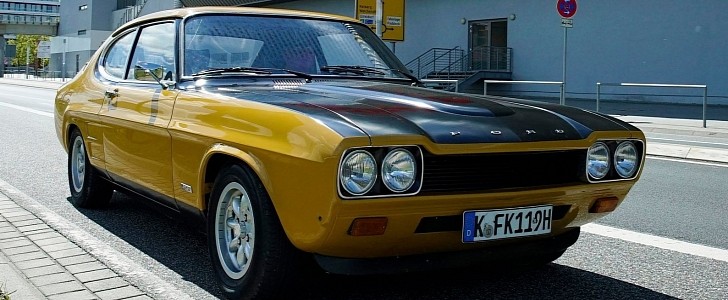Think of the Ford Capri as Europe's pony car. The relatively long hood promises a lot in terms of power and performance, while the overall design signed by Philip T. Clark breathes an uninhibited dynamic expression. The Capri's shape suggests it already left other cars in a cloud of smoke. It looks exactly like a reinterpreted Mustang recipe.
It came downsized compared to the American pony car, though. Usually, a Capri has only half the number of cylinders of a Mustang. Beyond this, the message for the passerby is something like: “jump aboard for the thrill or just continue to live your boring life forever.” Hard to resist it, but then again, all Capris were affordable, so why not? Well, probably because not all of them were RS2600s. Ford did sell plenty of Capris, though.
The Ford Capri Mk I debuted in 1968 and caused quite a stir. Underneath its body, there were the typical 1966 Cortina chassis components, including the live rear axle with leaf springs. The basic engine had a 1.3-liter displacement, while the top mills were 2.0 liters (the V4 came from the Taunus sedan, while the in-line four version was Pinto-sourced). Nothing really impressive so far.
During 1969 things improved: a 2.3-liter V6 Cologne engine (125 PS/123 hp) started its career in Europe, while the 3000 GT (Essex V6 engine with 140 PS/138 hp) was proposed to the Brits. These rather powerful engines only managed to show the limits of the chassis more clearly, though.
The situation changed significantly when Ford decided to promote the Capri through motorsport. And here comes the 1971 Ford Capri RS2600, produced as the basis for the Group 2 specifications of the European Touring Car Championship. The hood hid a modified Cologne 2.6 V6 engine (visited by Weslake), equipped with a Kugelfischer fuel injection and able to develop 150 PS (148 hp) in the street-legal version.
The gearbox's shorter ratios favored the acceleration (note the 7.7 seconds required for the 0 to 100 kph sprint), and the maximum speed exceeded the 200-kph (124-mph) threshold. Other decisive improvements included the resized brakes and modified suspension. Now that’s more like a sports car! On the other hand, its racing version was way more exciting: its 320 PS (316 hp) had to move a mass of only 900 kg (1,984 lbs). It proved to be a beast on the track as well, winning two consecutive championship titles.
The Ford Capri Mk I debuted in 1968 and caused quite a stir. Underneath its body, there were the typical 1966 Cortina chassis components, including the live rear axle with leaf springs. The basic engine had a 1.3-liter displacement, while the top mills were 2.0 liters (the V4 came from the Taunus sedan, while the in-line four version was Pinto-sourced). Nothing really impressive so far.
During 1969 things improved: a 2.3-liter V6 Cologne engine (125 PS/123 hp) started its career in Europe, while the 3000 GT (Essex V6 engine with 140 PS/138 hp) was proposed to the Brits. These rather powerful engines only managed to show the limits of the chassis more clearly, though.
The situation changed significantly when Ford decided to promote the Capri through motorsport. And here comes the 1971 Ford Capri RS2600, produced as the basis for the Group 2 specifications of the European Touring Car Championship. The hood hid a modified Cologne 2.6 V6 engine (visited by Weslake), equipped with a Kugelfischer fuel injection and able to develop 150 PS (148 hp) in the street-legal version.
The gearbox's shorter ratios favored the acceleration (note the 7.7 seconds required for the 0 to 100 kph sprint), and the maximum speed exceeded the 200-kph (124-mph) threshold. Other decisive improvements included the resized brakes and modified suspension. Now that’s more like a sports car! On the other hand, its racing version was way more exciting: its 320 PS (316 hp) had to move a mass of only 900 kg (1,984 lbs). It proved to be a beast on the track as well, winning two consecutive championship titles.














